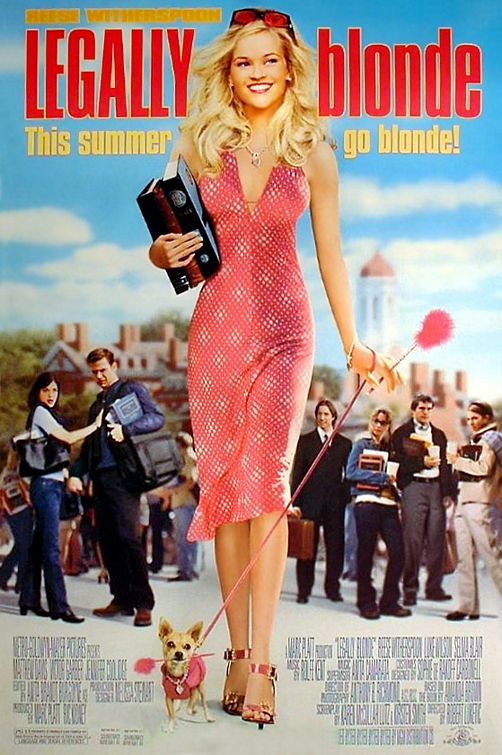I think about Legally Blonde pretty often.
Remember that one?
It’s the Reese Witherspoon movie in which she plays a fashion-loving, cutesy but serious but not too serious, budding, but of course kind of brilliant because it’s Hollywood, pink in a world of grey, girlie-girl lawyer.
At least I think that’s what it’s about. I don’t remember the movie very well at all, to be honest.
What I remember is hearing the director or the producer or someone important talking about the poster and changes he had to give the designers.
I remember the hair on the back of my neck tingle as I instinctually went into a defensive stance. I had to protect me and my kind; designers against arrogant clients!
As I snarled my teeth at the screen he said something to the tune of “so I told them to zoom out. They had the promotional materials cropping Reese from the wait up! I said no! Show the shoes! There was concern about how small that might make her on the poster, but I reminded them that her character is one who takes pride in her appearance, from hair to shoes. Show the shoes.”

Oh, yeah yeah, ok, that’s pretty smart.
What Story Are You Telling?
This gave me a germ of an idea I’ve been thinking about for years since. Waiting in line for take-away Thai, looking over at the local Blockbuster (yeah, Australia, the country that pirates more American TV than America still has Blockbuster), I’d look at the posters and try to figure out what stories they’re trying to tell me.
It’s surprising how often they’re not so much of anything. I’d hate to try and pick the next flick I watch based on what I see in the posters alone – it’d be a little bit stressful, I think.
Often a design is successful because it tells a story. Stories are wonderful things because they help us to absorb complex ideas – they teach us something difficult in an easy and, hopefully, memorable way.
In doing so, designers can help ease the stress of the audience. They can understand something in a second rather than a minute, find a key piece of information on a site packed with it in a minute rather than an hour.
It’s another question worth asking at the very start – “what’s the stress we’re trying to ease?”
Their Story Sucked So Hard I Stopped Paying
If it’s a site for your local cinema, then the stress is pretty straight forward – what movies are playing, probably in the next few hours, and how I can I buy a ticket?
A few years ago the cinema chain our local complexes were part of was bought and with it came the usual – a new logo, new branding, and a new website. Unfortunately the last of these was a complete disaster. Instead of one or two clicks to find the information I needed, it’d take about half a dozen pages and twice as many clicks. It was aggravating. We didn’t go to see a movie for a few months because of it.
My story was that I wanted to buy a movie ticket.
If you’re building a site for a library, then make sure the search works perfectly and they can easily see if what they’re searching is available and when it’ll be back. Be a rockstar and add the option to reserve it.
This is a story about reserving a book.
If it’s a poster talking about an event or unveiling coming on a certain date, then make sure you have a website or social media account they can follow so they are aware of what that something is on the date – it’s too dangerous to assume people will happen to see the new lot of posters that will be rolled out.
This is a story about a confused and frustrated girl whose excitement for a hot new launch quickly turned to frustration. Starring Sarah McDisney.
Tell Yourself A Few Stories
Let’s go back to stories.
When you’re designing something, or doing the planning before the work of defining balance and structure and hierarchy and all that fun stuff, then tell yourself a story about the user.
Imagine they’re walking or browsing past your design.
Think about how they’ll find what you’ve worked on, what their reaction might be, both physically and emotionally and what they’ll do with their attention. Think about if these things will align with the goal you’re after.
It’s so easy to get caught up in the visuals that we forget that our work needs to achieve something, often a reaction of sorts. Sometimes that reaction means they’re doing more (going to a website) or deliberately doing less (blocking distractions so they can read), but there has to be something.
We need to make sure these stories run as easily as possible. No dragons, no invading army from the north, just a wedding without poison.
The story wrapped up in the design, the one about shoes and hair? That’s often the story of why. Why should they care? Why should they bother clicking the link, or buying the movie ticket.
It can be a fun game to throw around with colleagues. What’s the story of your audience member, and how will they understand the story of your design?
Take care of both and a lot of stress will be eased.
Master Your Craft.
Weekly.
Become the designer you want to be.
Join a group of talented, creative, and hungry designers,
all gaining the insight that is helping them make
the best work of their lives.